Second core.
D I S T R I B U T I O N
The second core of our ATHENA AI is "DISTRIBUTION."
Architecture is the science of the placement of each element—from the light bulb or the door to the park and avenues.
Our AI is capable of thinking in three-dimensional space and placing the element in the precise location. Only you define the parameters.

V I D E O D E M O
ATENEA sees more than just architecture; it sees a 3D world, full of points, where each point is the ideal location to place an element, from a beam to an entire building in space. All these locations offer infinite possibilities for distribution and, therefore, for possible designs. The chosen points must meet standards and criteria; each point must have a material (for example, wood or concrete). And each point must relate perfectly to the other points.
Beyond architecture.
ATENEA, together with its specialized "Distribution" core, offers comprehensive solutions ranging from small-scale space optimization, such as furniture reorganization and area zoning, to larger projects, such as urban design and planning.
Areas of opportunity.
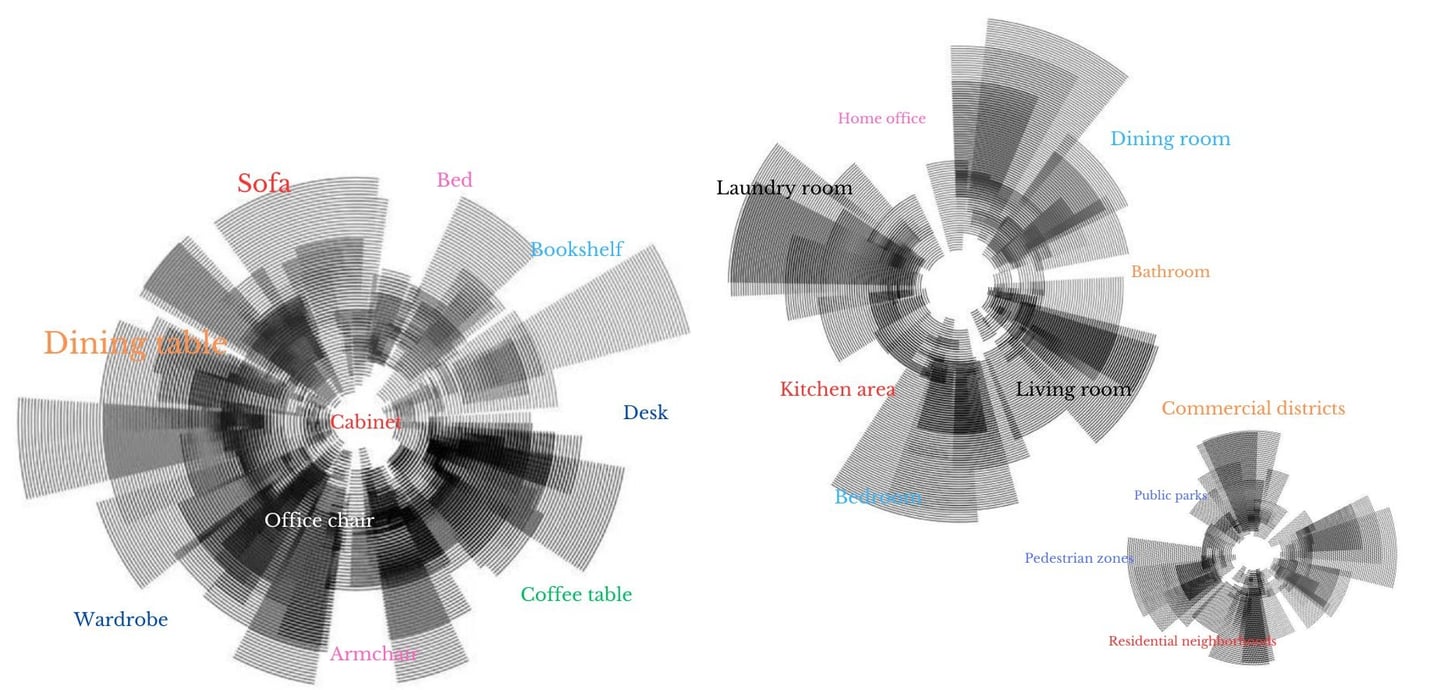

ATENEA, with pre-established parameter rules uploaded in a .zip file, creates a zoning diagram as a base, from which it can distribute the project into dozens of options that respect the requirements, creating a creative and specific variety of projects to choose from.
APPLICATION:
Zoning.
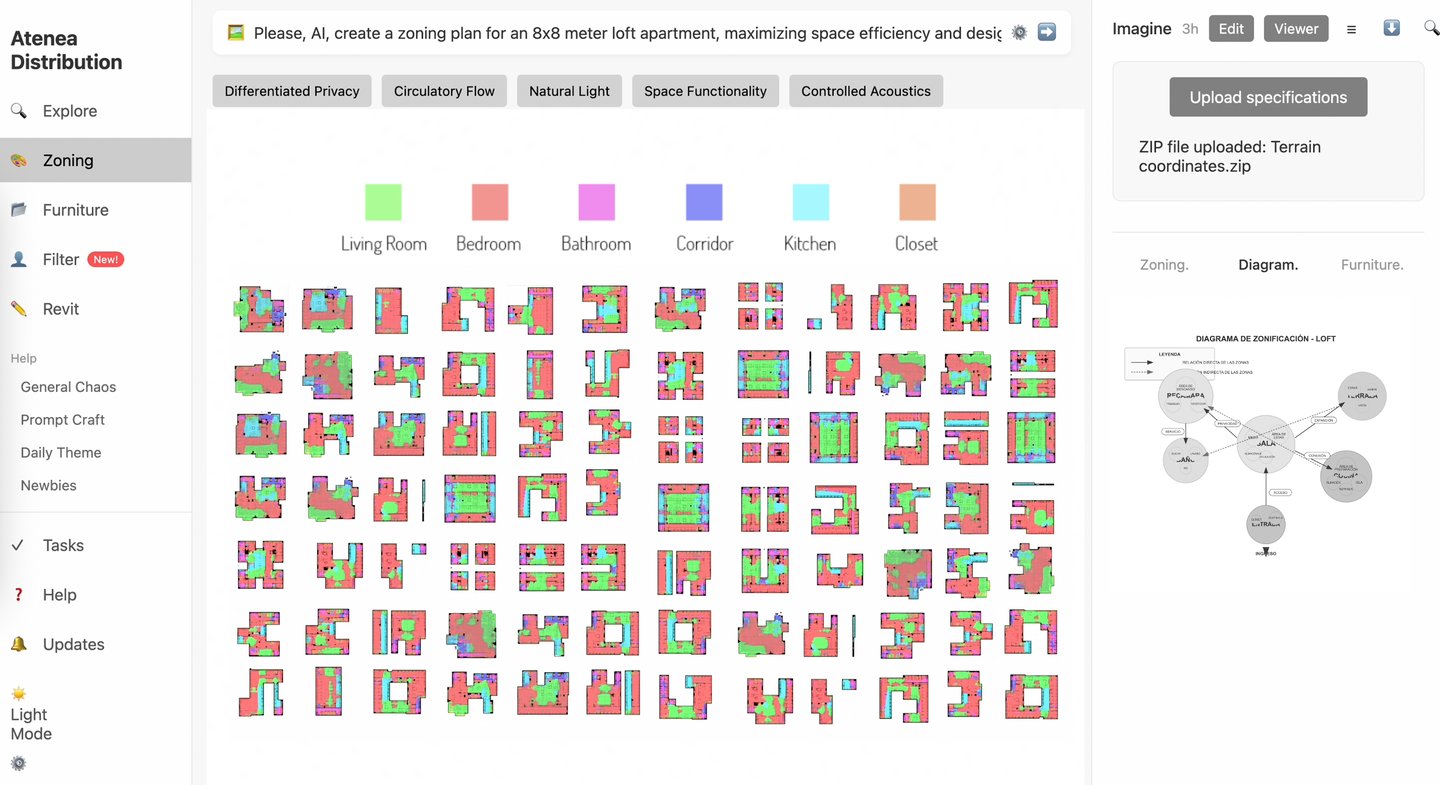

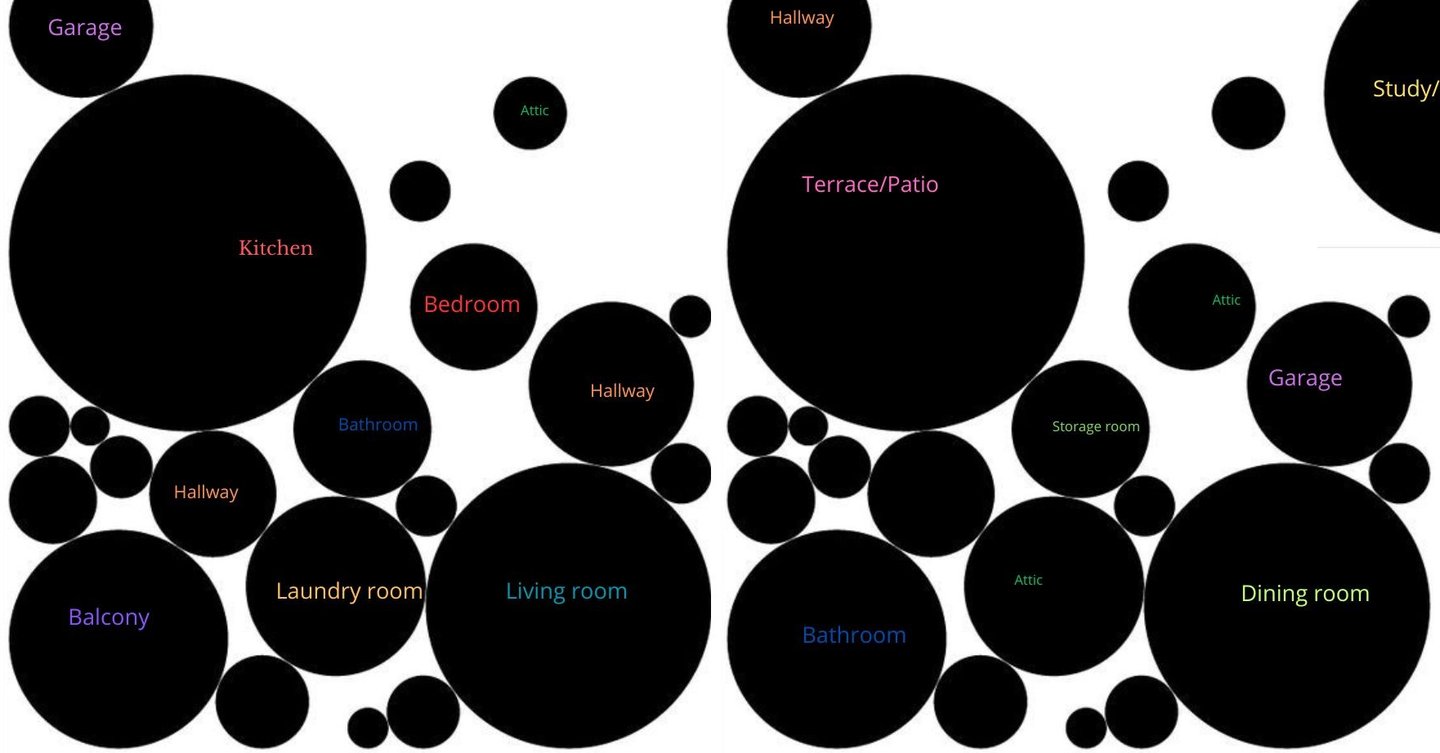

In zoning, Atenea revolutionizes design by generating thousands of possible combinations based on dimensions, regulations, and specific needs. Using advanced algorithms, it analyzes and selects optimal configurations that maximize functionality, flow, and land use. This process, which previously took hours or days, is now completed in minutes, opening up previously unexplored creative possibilities and ensuring innovative and efficient solutions for every project.
Advantages
ATENEA, together with its specialized "Distribution" core, generates tens of thousands of furniture combinations in seconds, respecting zoning, rules, and minimum/maximum areas. By adjusting to any perimeter, it reveals innovative designs, expanding the architect's creativity and strategically optimizing spaces.
APPLICATION: Distribution of internal furniture.
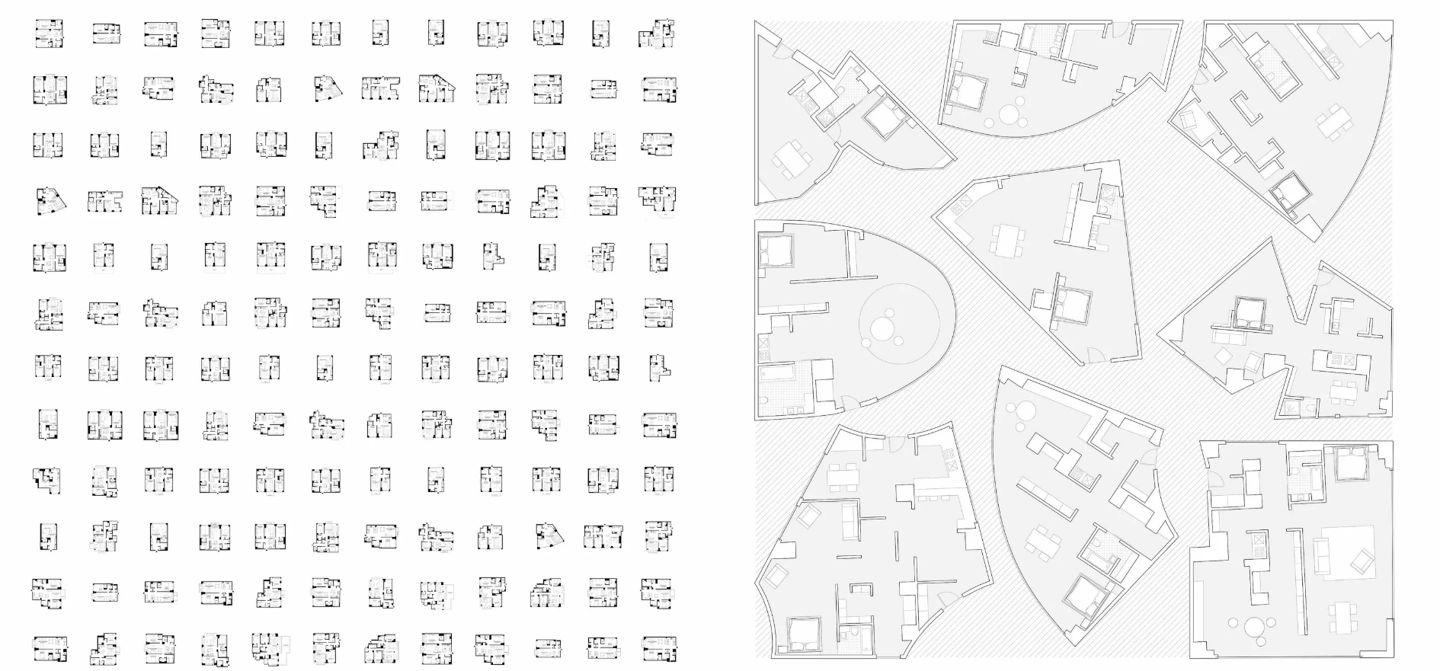

*The video shows the furniture layout by changing the perimeter and area of the space. The image shows dozens of different apartment layouts. Author: Stanislas Chaillou
The video shows the furniture layout and zoning. Author: Stanislas Chaillou
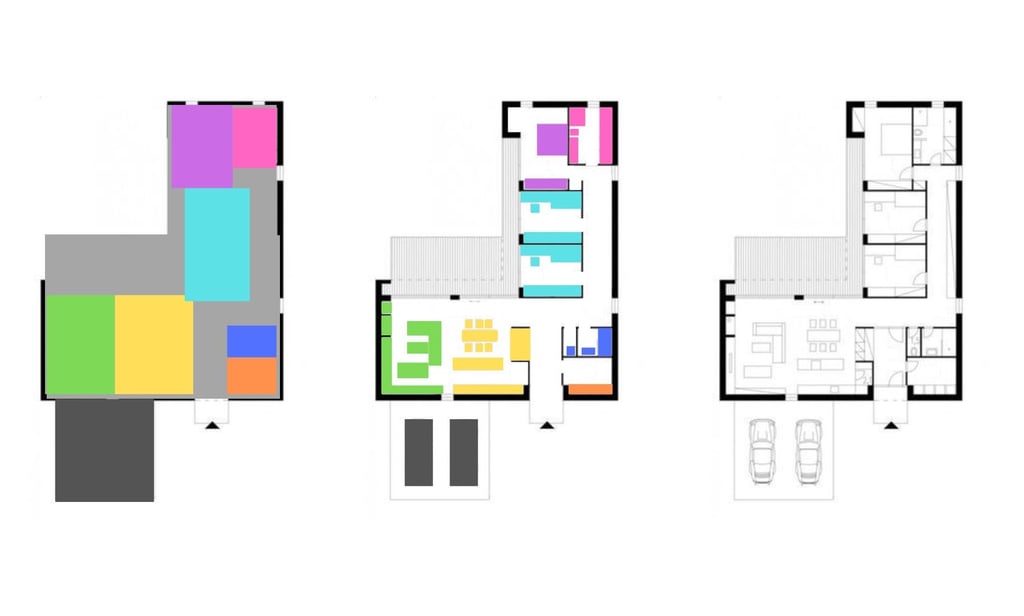

*The image shows the result of zoning, furniture placement and the final floor plan of an apartment.
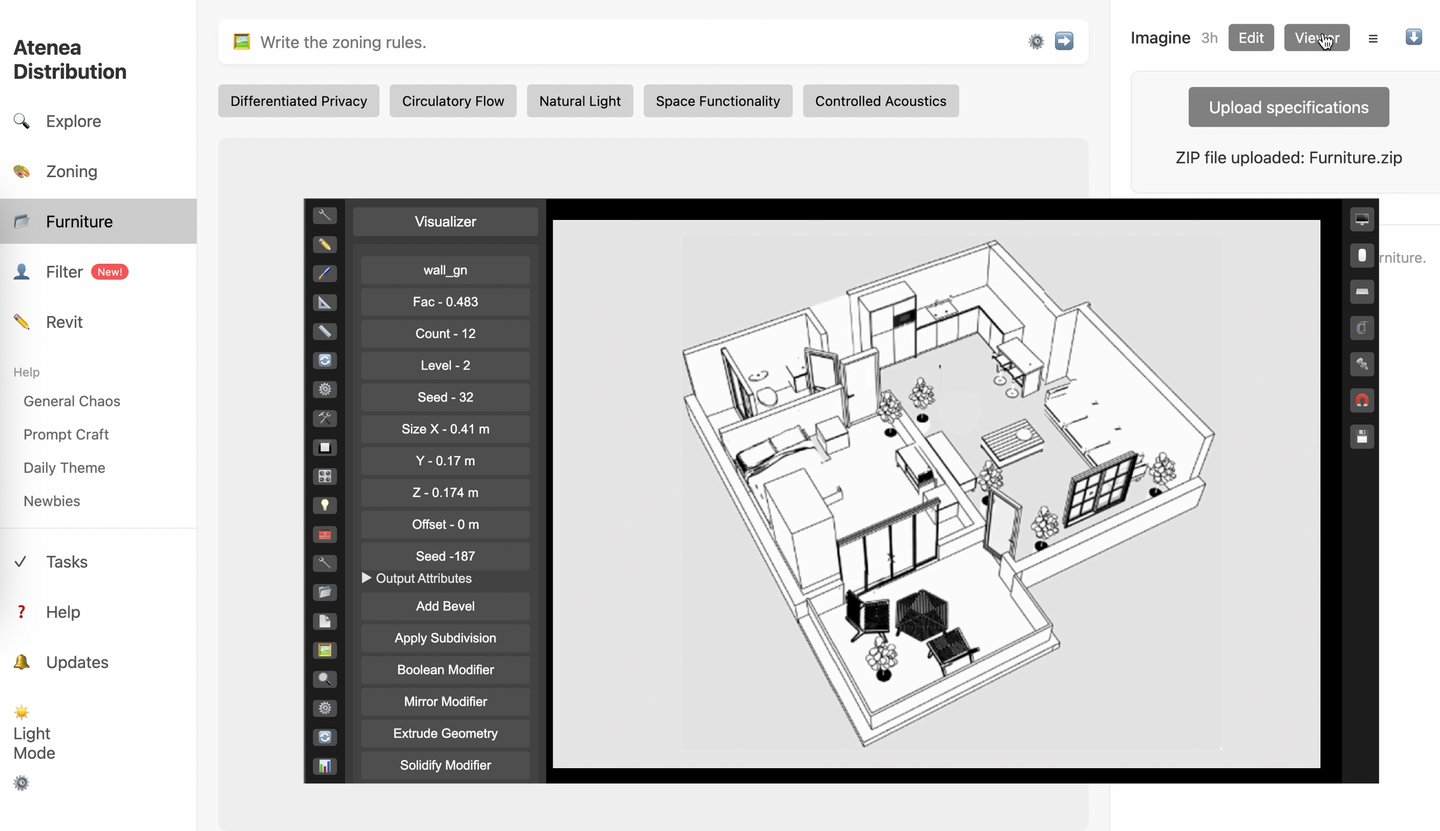

Atenea transforms furniture layout by generating thousands of intelligent combinations in minutes. It evaluates flows, ergonomics, and functionality to maximize the use of space, creating innovative designs tailored to any need.
Atenea is capable of converting 2D designs to 3D models—including furniture, materials, floors, windows, doors, walls, facades, and more—in a matter of seconds. From now on, modeling has never been so easy and fast.
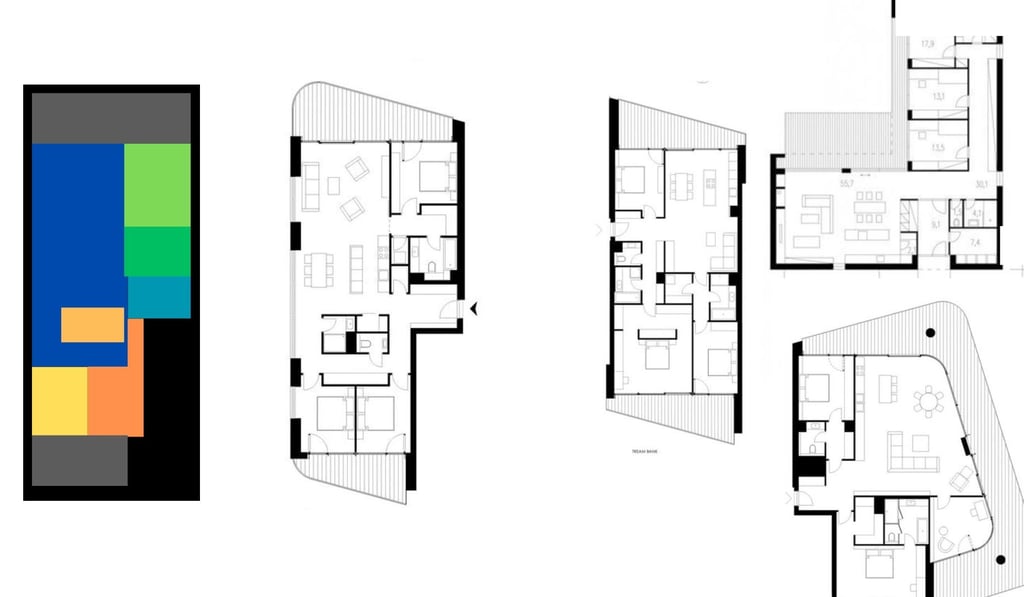

* Dozens of options for distributing furniture in an apartment, both in 2D and 3D, with pre-established rules, for example, ensuring that the total area of the apartment is the same.
* Difference from step II. zoning to III. distribution.
Athena works with a simple plugin in Revit, seamlessly integrating into the architect's workflow without complications. This plugin allows you to harness the full power of artificial intelligence directly within the Revit environment, facilitating automated and optimized design in just a few clicks.
The main benefit of using Athena is simplicity: there's no extensive learning curve or platform switching required. With Revit, we gain access to an even greater amount of data and information, such as detailed BIM models, allowing Athena to work with incredible precision, delivering fast and efficient solutions without sacrificing design quality.
Integrating Athena with Revit maximizes productivity, saving time on repetitive tasks, and opens up new possibilities in space creation, allowing architects to focus on what really matters: creativity and innovation.
All this in REVIT.
*The video shows the internal rearrangement process, when changing the perimeter of the retail store. At the end of the automatic rearrangement, a button is used to switch to 3D interior furniture and a 3D facade with roof. Finally, the plans are extracted.
ATENEA organizes spaces efficiently: from kitchen and apartment furniture to parking, mixed-use buildings, universities, and urban planning. With parameters (dimensions, regulations) and rules (flow, sustainability), it generates dozens of customizable options. It combines spatial optimization, scalability, and adaptability, offering intelligent modular solutions for every need.
APPLICATION:
Urban planning.
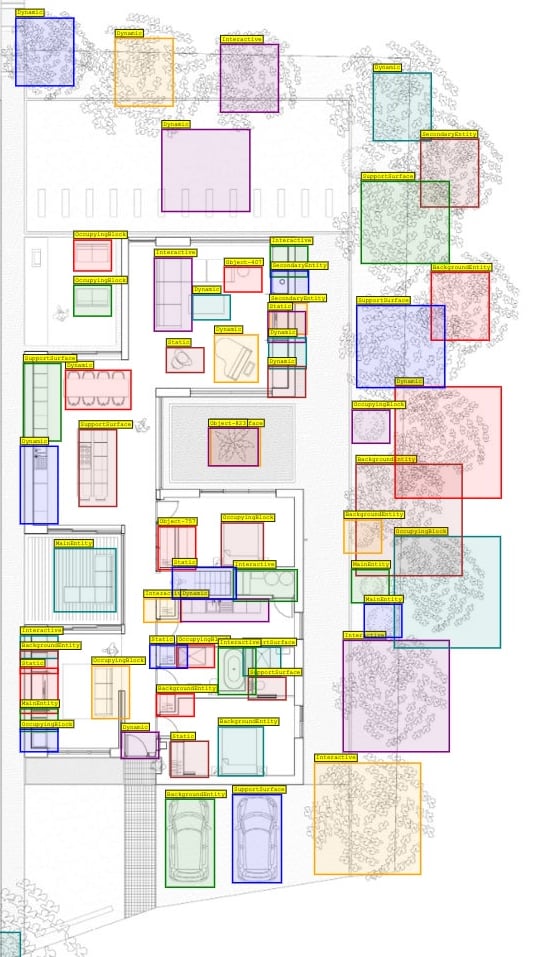

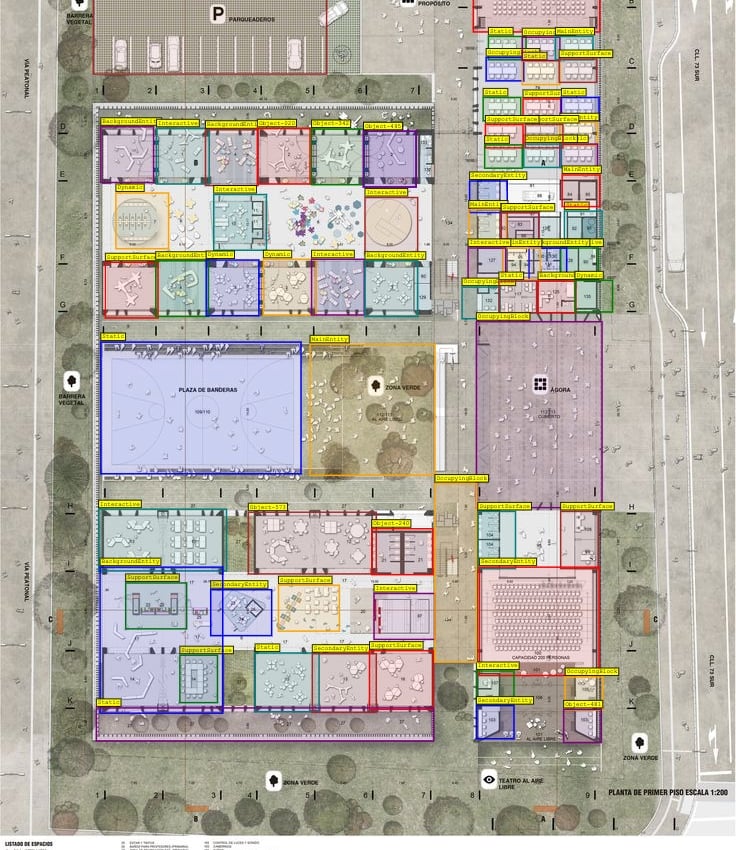

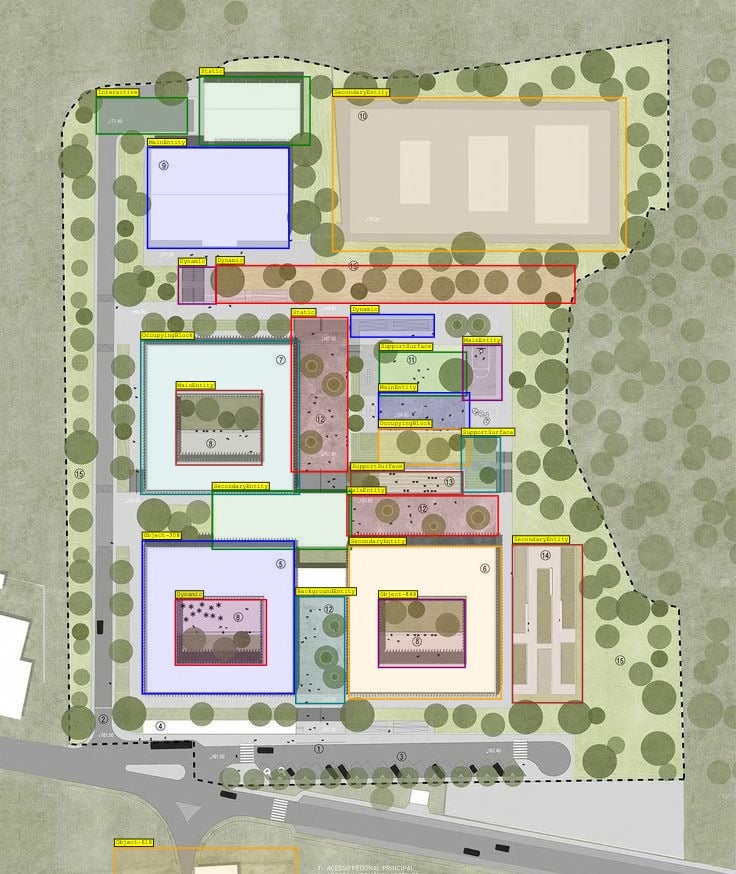

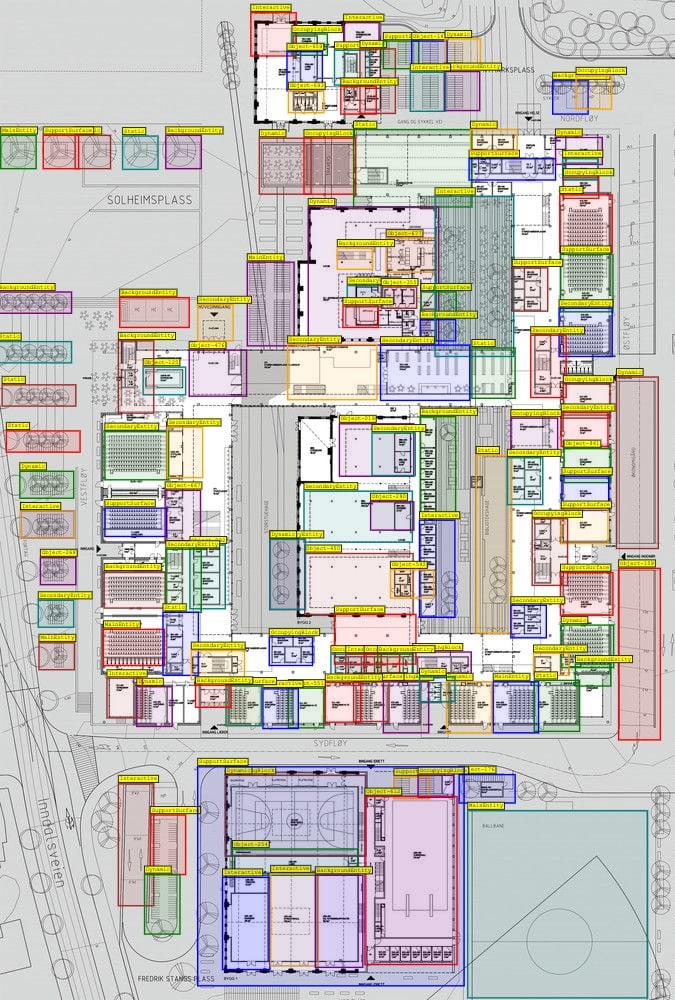

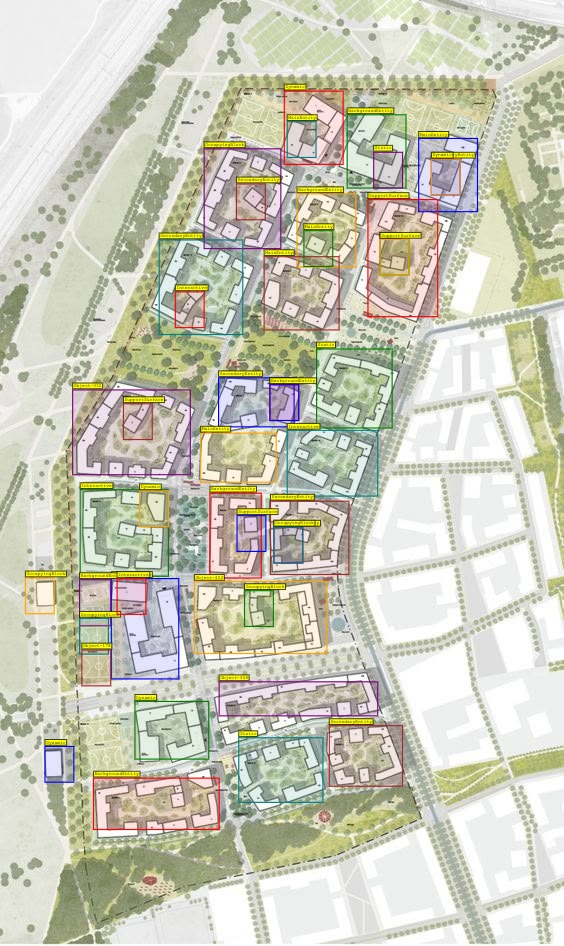

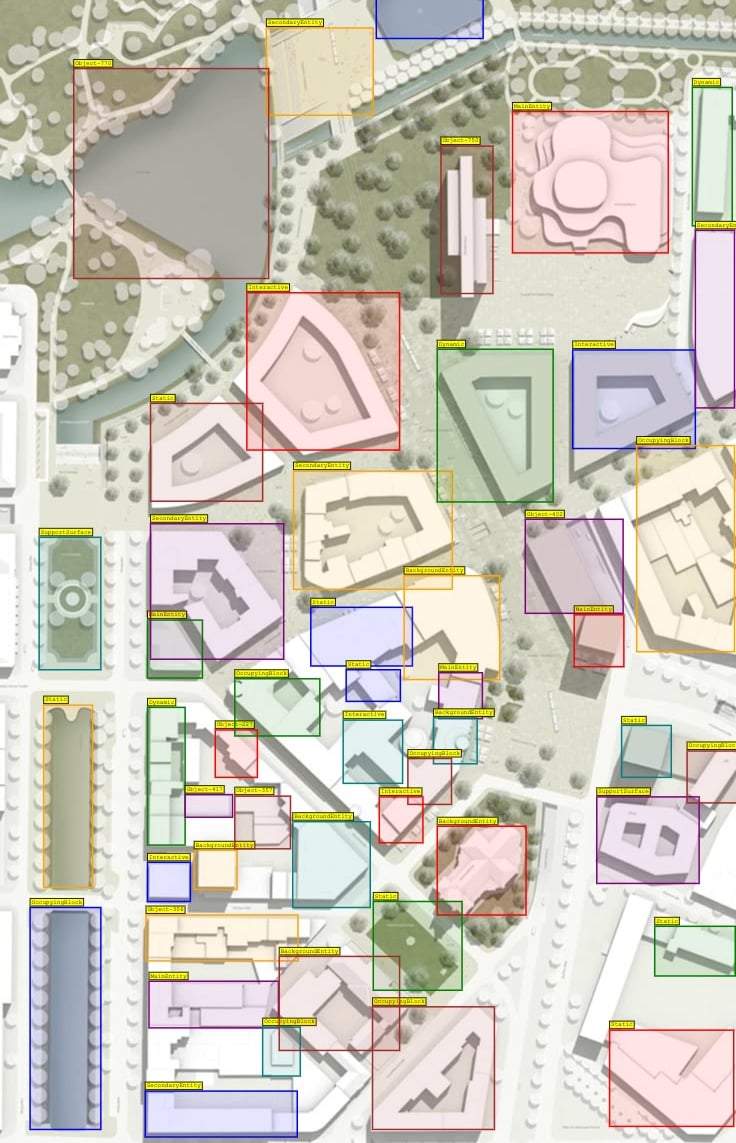

*The image shows how computer vision uses the floor plan to automatically identify and distribute the objects present. By analyzing the defined coordinates and variables, each element is segmented and represented in labeled squares, facilitating the organization and subsequent interpretation of the space.
November 2024. IXA IA Research Team.
Introducing (SREI) the Intelligent Spatial Reorganization System: the engine behind IXA AI.
At Ixa IA, we have developed an innovative artificial intelligence system called SREI. This system is capable of identifying and visualizing perimeters, regardless of the given perimeter (the perimeter is equal to an infinite number of possible shapes).
The SREI, based on distribution rules, will provide an optimal distribution response for that perimeter, facilitating direct modeling of spatial layout and furniture placement. From infinity to the finite.
Why an AI that distributes spaces?
PROOF
Designing and laying out a space, for example, for each new branch of an expanding retail company, individually is a considerable challenge, primarily due to the manual approach that still prevails in many processes.
Despite available technological solutions, such as CAD blocks or pre-built designs in Revit with their component families, the process retains a significant artisanal nature. Each project requires adjustments and customizations that, while facilitated by these tools, do not completely eliminate the need for manual intervention. This reliance on manual labor not only consumes essential time but also introduces the possibility of inconsistencies and errors, which can lengthen delivery times and increase operating costs.
In this context, the adoption of more automated, AI-based techniques could represent a fundamental change, streamlining the design process and freeing up valuable resources to focus on more innovative and strategic aspects of architectural development.
The test was divided into three parts and carried out with 25 architects, who performed the same tasks to obtain an average time taken, measured in minutes.
Test 1: Model the exterior of a new retail store, in which the regulations and type of perimeter must be reviewed. Test 2: Arrangement of furniture within the store, following pre-established rules. Test 3: Model the store's exterior, including the sidewalk and parking area, as well as the extraction of architectural plans.
How time affects, manually and with AI.
CAUSE
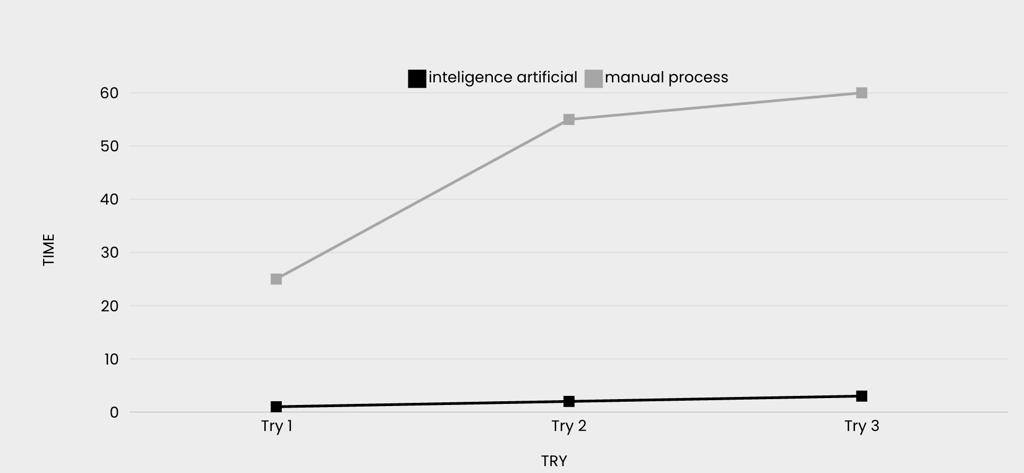

SREI
How does it work?
The software implements a semantic tagging approach and structured analysis of extensive repositories of architectural drawings. Each drawing is digitized and tagged with detailed metadata describing specific characteristics, such as furnishings, zoning, and functionality, facilitating advanced processing and efficient searching within the database.
Our artificial intelligence, called the Spatial Reorganization Intelligence System (SREI), focuses on interpreting coordinates within an XY plane, operating under a rigorous framework defined by pre-established rules that guide the distribution of space. Using advanced computational geometry algorithms, the AI analyzes and assigns XY coordinates to efficiently map elements within the designated space. This approach allows the AI to visualize and manipulate spatial data as a series of points on a plane, each represented by specific coordinates that correspond to the precise location of architectural components.
These algorithms not only calculate the best positions for each element based on maximizing space utilization and meeting requirements. By treating design as a point optimization problem in two-dimensional space, AI can execute complex design solutions quickly and accurately, significantly reducing project development time and increasing the accuracy of implementing architectural plans.
These rules are adaptable and can be configured to meet the unique specifications of any project, ensuring that the proposed design maximizes space utilization while meeting the client's regulations and functional requirements. Upon approval of the two-dimensional configuration, the design is automatically exported to Autodesk Revit for transition to a three-dimensional model. The software automates the construction of structural elements, fixtures, and finishes.
Let's look at a simple example. We'll simplify 3D space and work in 2D.
The problem is clear: we need to distribute gondolas in a given area.
(In the first image) you can see that only the data in Excel is needed, in this case the perimeter of the area. (Second image) within the code, in REVIT and connected to our AI, it sends the request.
(Third image) the AI generates multiple combinations, rotating the gondolas, adjusting their quantity, models, and sizes, always respecting the minimum and maximum space limits between them. After analyzing the options, the optimal distribution is determined and an Excel file is generated with the exact location coordinates.
(Fourth image) These coordinates are transferred to REVIT, obtaining the desired result. This method can be applied to the distribution not only in 2D (X,Y), but also in 3D (X,Y,Z), of houses, cities, facilities, or any other element that requires spatial organization.
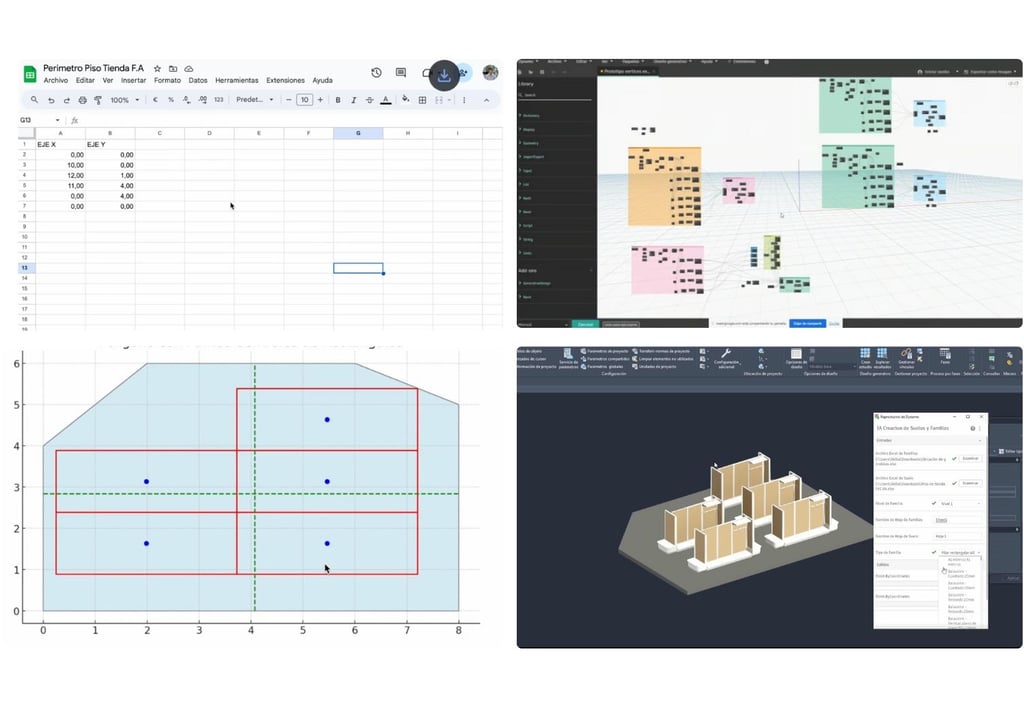

The points
EXAMPLE
EVIDENCE
First steps.
In our effort to revolutionize the field of architectural design, we have conducted a series of extensive tests to evaluate our system's ability to adapt and optimize furniture layouts in a variety of perimeter profiles.
To ensure the relevance and applicability of our results, diverse furniture samples representative of a retail store environment were selected as the first test, ranging from shelves and counters to display areas and customer service points. Throughout this process, our AI underwent rigorous testing that included adaptation to multiple store profiles, from compact and efficient spaces to vast retail areas with complex design needs.
These experiments are only the first step toward fully validating our technology. We recognize that the controlled test environment may differ from real-life situations. Therefore, we are committed to continuing to develop and refine our AI to ensure its adaptability and efficiency in the dynamic world of architectural design.
Note: It is important to emphasize that the tests referenced here were conducted in a controlled environment and specifically designed to evaluate the functionality of the AI system (SREI). The results obtained may vary when applying the software in real-world conditions and with design parameters different from those of our test environment. Furthermore, the behavior and effectiveness of the AI (SREI) may fluctuate depending on the complexity and specific characteristics of each architectural project.
The evaluation process was structured in several stages:
Test scenario generation: Different architectural plans were designed under varying conditions.
System execution: The AI processed the plans and generated layout proposals.
Comparison with human references: The AI-generated designs were compared with solutions created by professional architects.
Analysis and scoring: A rating system based on quantitative (placement accuracy, compliance with standards) and qualitative (expert evaluation of the design logic) metrics was applied.
On this scale, a score of 10 indicates extremely high accuracy, comparable to that of a human, while a score of 0 represents no accuracy at all.
Score 9. Try one: Furniture Placement Accuracy: Refers to the AI system's ability (SREI) to accurately place furniture on the architectural plan.
Grade 8. Test Two: Respect Design Rules: Evaluate how the AI (SREI) follows the architectural design rules predefined by the company.
Grade 9 Test Three: Layout Logic: Analyze the efficiency of the AI (SREI) system in zoning assignment. This is key as a first step; before placing furniture, the zoning must be logically consistent with the rules.
Grade 8. Furniture Logic: Consider the reasoning of the (SREI) system when selecting and placing each piece of furniture, keeping functionality in mind, to ensure that each element contributes positively to the overall design.
This result reflects high precision in furniture placement and rigorous adherence to design rules, with small opportunities for improvement in zoning logic and furniture functionality.
While the results in a controlled environment have been highly satisfactory, we recognize that its performance may vary in real-world applications. Therefore, we are committed to continuing to optimize the system, ensuring its effectiveness in various architectural contexts.
This evaluation process not only validates the current capabilities of AI but also establishes a solid framework for its future development, with the goal of offering intelligent and efficient solutions in architectural design.
Conclusion.
20 Manhattan Ave,
New York, NY 10025, EE.UU
irving@ixaia.com
